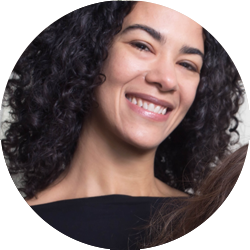“Why does Daddy have a stomachache?” Our toddler began to cry. “Daddy, I will help you,” she said.
We were playing Chutes and Ladders, a gift from her 3rd birthday party earlier that week. Her daddy landed on square 49, in which a boy eats an armful of green apples. He had to slide all the way back down to square 11, where the boy looks ill. “AWW!” he said.

“OO-OOH!” I said with a laugh. “Daddy ate too many apples! Now he has a stomachache!”
That’s when our daughter got sincerely concerned. We had stop and to explain that it was just pretend, just describing the image on the board game.
Later, I thought of a study of kindergartners where the researchers and the children have a conversation entirely through dolls, talking about a scenario that hadn’t actually occurred. When I first encountered the study, I thought, “What? How realistic can the kids’ responses really be?” But the children readily insert themselves into the scenario. What they have their doll say is clearly based on how they themselves are thinking or feeling. And the researchers are able to come away with some incredibly useful conclusions. (In this case, about the best way to criticize children.)
Young children confuse fantasy and reality: It’s an idea from 1930 that you can still hear parents repeat today. That’s why the above research method works–and why my daughter got upset during our board game, right?
Not exactly.
Psychologists Tanya Sharon and Jacqueline Woolley were intrigued that this idea still held sway, even though children by age 3 make plenty of distinctions between what’s real and what’s not. For example, tots can tell that a photo of a ball is not the same as the ball itself. If we interrupt their tea party for stuffed animals, they can immediately respond to us and then jump back into pretending.
Sharon and Woolley devised a new study testing preschoolers’ ability to distinguish reality from fantasy. Maybe some previous studies were too narrow. Knowing that children develop an understanding of physical and social properties before an understanding of biological and mental properties, for example, Sharon and Woolley wanted to allow for differences in these domains.
The researchers showed 64 children drawings of things like a monster, Santa, a child. They asked questions across the four domains: biological (does X get older every year?), social (does X eat dinner with family sometimes?), physical (can someone touch X?) and mental (can X know what we’re thinking?).
Five-year-olds’ answers matched that of adults’. Four-year-olds were better at assigning physical and social properties than biological and mental properties. And three-year-olds, if you looked at which beings they thought were real, were already assigning social properties to their real beings more than their pretend ones (same as the five-year-olds). It’s an interesting peek at the rungs of this particular developmental ladder.
The children then were asked to sort pictures–a clown, a dinosaur, a dragon, the Easter Bunny, Superman–by whether the thing was real. And they weren’t great at choosing the correct category. (Especially where social cues pointed them to the incorrect one; e.g. Santa is real. This is likely why my daughter thought her daddy had a stomachache: I had said so.)
But instead of “real” or “pretend” as the only options, as was common in previous studies, children could choose “not sure.”
Children chose “not sure” a lot.
More than 20% of the time overall–often more than 30%–the kids were uncertain. Sharon and Woolley write: “This is a very different kind of confusion than confidently holding a belief in the incorrect reality status.”
Children are simply still acquiring knowledge about the world. But they’re not dismissing the bits and pieces they’ve picked up so far. As the researchers theorize:
[A]t the same time, as children believe in the reality of fantasy figures, or are unable to say with certainty that they are pretend, they treat them very differently from real entities in terms of the properties and abilities they are willing to grant. In this way, children seem to place fantastical entities in a separate category—neither unquestionably real nor pretend, but somewhere in between. This category could then form a natural bridge to the adult category of fantastical entities.
Thus, rather than having misplaced the boundary between real and fantastical entities, young children are still in the process of actively constructing it.
That may be why our daughter readily accepted our explanation that daddy didn’t really have a stomachache. Tears dried, we happily continued our game of Chutes & Ladders.
I’m pretty sure she won. Her daddy never did recover from that slide.
Has your child had a reaction that really surprised you? Let me know at tracy@zerotofive.net–I may write about it.
Written by
Tracy Cutchlow
Tracy is the author of the international bestseller Zero to Five: 70 Essential Parenting Tips Based on Science, a public speaker, and a creator of places to speak and be heard. Sign up for her newsletter here.

